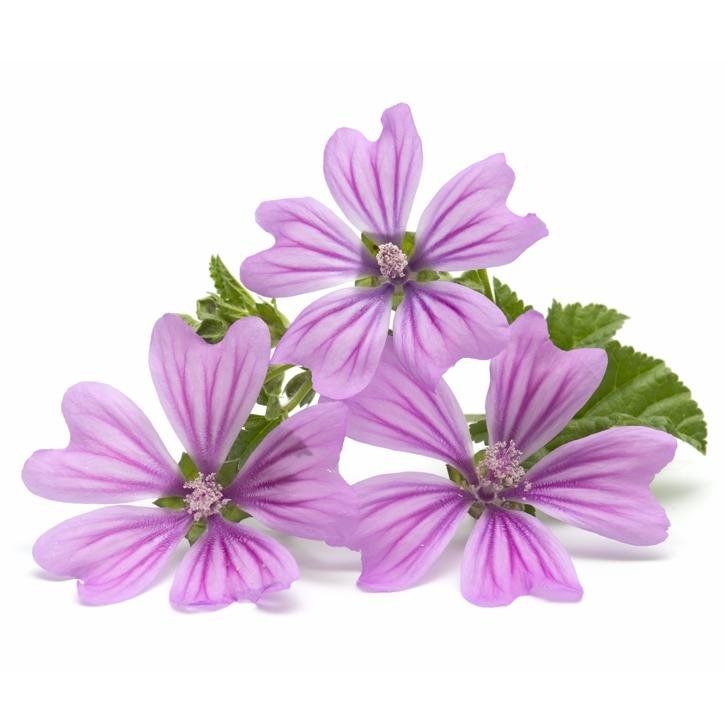Description
Biannual or perennial plant with a fusiform, axonomorphic and very fleshy root. Stem is erect or decumbent, thick, cylindrical, very hairy, ligneous at the base, it can reach 1 m high. Leaves are palmate in 5-7 lobes with long petioles, alternate and crenate or serrate margins, pubescent (simple and stallate hairs) with stipules. When the leaves are young they are dark green with a pilose petiole. Flowers are violet-pink streaked in purple; 2-3 cm, displayed in axillary fascicles. The corolla is formed by 5 petals, long-heart-shaped. Sepals two to four times smaller than the petals. From the middle of the corolla a single bundle with several stamens, fused by their filaments in a column surrounding the style, covered with pollen. Aggregate fruit or achenes, schizocarp formed by ten mericarps that detach themselves when mature. The fruit is yellowish with kidney-shaped seeds. It belongs to the Malvaceae family.
It’s original from Europe. It grows spontaneously in any kind of land, as long as they are not too dry. It blooms from spring to late summer. Mallow flowers are harvested in early spring, before they open (between June and August). Leaves are to be collected when the plant is flowered in spring or summer (between June and September).
Part used
The flowers and, sometimes, the leaves, too.
Indications
Internal use
- Gastrointestinal mucosa inflammation: gastroesophageal reflux, gastritis, gastroduodenal ulcer, enteritis.
- Inflammation of the respiratory mucosa: catarrh, pharyngitis, laryngitis, hoarseness, tonsillitis, asthma, flu, bronchitis.
- Dry or irritant cough.
- Chronic constipation: acts as a non-aggressive laxative that lubricate the intestinal tract. It is recommended especially for children and elderly people.
- Urinary tract mucosa inflammation: cystitis, urethritis, pyelitis, oliguria (lack of urine output).
- Obesity.
External use
- Pharyngitis, glossitis, stomatitis, aphtas and sores in the mouth and toothaches, in gargles.
- Vulvovaginitis (vaginal irrigation and enteroclisis), anal and rectal inflammation.
- Blepharitis, conjunctivitis with compresses and eye washes (isotone).
- Abscesses and furuncles (hot poultice), wounds, eczema, dermatosis, acne, ulcer or any other kind of skin lesions.
- Insect bites (juice of the fresh plant).
Bibliography
- JB Peris, G Stübing y B Vanaclocha. Fitoterapia Aplicada. Ilustre Colegio Oficial de Farmacéuticos de Valencia. Valencia 1995.
- J Bruneton. Farmacognosia, fitoquímica, plantas medicinales. Editorial Acribia. 2ª edición.
- Catálogo de plantas medicinales. Consejo General de Colegios Oficiales de Farmacéuticos. 2003.
- B Vanaclocha, S Cañigueral. Fitoterapia Vademecum de Prescripción. Editorial Masson 4ª edición.
- PDR for Herbal Medicines. Medical Economics Company, Montvale. Second Edition, 2000; pp395-6.
- Carretero E. Glúcidos (IV): mucílagos. Panorama Actual Med 1999; 23(229): 953-
- Benigni, R; Capra, C; Cattorini, P. Piante Medicinali. Chimica, Farmacologia e Terapia. Milano: Inverni & Della Beffa, 1962, pp. 913-5.
- Bézanger-Beauquesne, L; Pinkas, M; Torck, M. Les Plantes dans la Therapeutique Moderne. 2ª. Paris: Maloine, 1986, pp. 279-80.
- Bézanger-Beauquesne, L; Pinkas, M; Torck, M; Trotin, F. Plantes Médicinales des Regions Tempérées. Paris: Maloine, 1980, p.148.
- Paris, RR; Moyse, M. Précis de Matière Médicale. Tome II. Paris: Masson, 1967, pp. 249-51.
- Trease, GE; Evans, WCh. Farmacognosia. México D.F.: Interamericana--MacGraw-Hill, 1991, p. 452.
